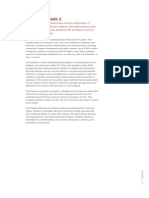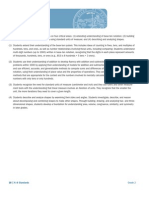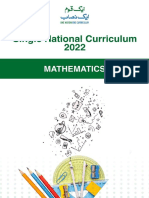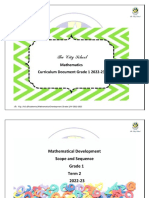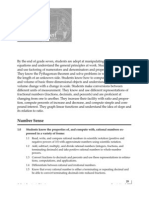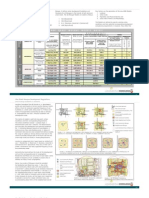0 ratings0% found this document useful (0 votes)
37 viewsNumber and Place Value: Subject: Math Year: 2
Number and Place Value: Subject: Math Year: 2
Uploaded by
madeehaThe document outlines a math curriculum for year 2 students covering topics like number and place value, addition, subtraction, multiplication and division, fractions, measurement, geometry of shapes and position, and handling data. Key learning outcomes are defined for each topic.
Copyright:
© All Rights Reserved
Available Formats
Download as DOCX, PDF, TXT or read online from Scribd
Number and Place Value: Subject: Math Year: 2
Number and Place Value: Subject: Math Year: 2
Uploaded by
madeeha0 ratings0% found this document useful (0 votes)
37 views7 pagesThe document outlines a math curriculum for year 2 students covering topics like number and place value, addition, subtraction, multiplication and division, fractions, measurement, geometry of shapes and position, and handling data. Key learning outcomes are defined for each topic.
Original Description:
SNC Pakistan
Original Title
TLE's_Math_Year2
Copyright
© © All Rights Reserved
Available Formats
DOCX, PDF, TXT or read online from Scribd
Share this document
Did you find this document useful?
Is this content inappropriate?
The document outlines a math curriculum for year 2 students covering topics like number and place value, addition, subtraction, multiplication and division, fractions, measurement, geometry of shapes and position, and handling data. Key learning outcomes are defined for each topic.
Copyright:
© All Rights Reserved
Available Formats
Download as DOCX, PDF, TXT or read online from Scribd
Download as docx, pdf, or txt
0 ratings0% found this document useful (0 votes)
37 views7 pagesNumber and Place Value: Subject: Math Year: 2
Number and Place Value: Subject: Math Year: 2
Uploaded by
madeehaThe document outlines a math curriculum for year 2 students covering topics like number and place value, addition, subtraction, multiplication and division, fractions, measurement, geometry of shapes and position, and handling data. Key learning outcomes are defined for each topic.
Copyright:
© All Rights Reserved
Available Formats
Download as DOCX, PDF, TXT or read online from Scribd
Download as docx, pdf, or txt
You are on page 1of 7
PY and MY - Teaching and Learning Engagements 2020-21
Subject: Math Year: 2
Sr. No Topics Learning Outcomes
1 Number and place value Students will be able to:
Count in steps of 2, 3, and 5 from 0, and in tens from any
number, forward or backward
Read and write numbers at least till 100 in numerals and in
words
Compare and order numbers from 0 up to 100; use <, > and =
signs
Recognize the place value of each digit in a two-digit number
(tens and ones)
Identify, represent, and estimate numbers using different
representations, including the number line.
Estimating
Use place value and number facts to solve problems
2 Addition, subtraction, multiplication Students will be able to:
1)Recall and use addition and subtraction facts to 20 fluently, and
and division (calculations) derive and use related facts up to 100
2)Add and subtract numbers mentally, including:
• a two-digit number and ones
• a two-digit number and tens
• two two-digit numbers
• adding three one-digit numbers
3) Add and subtract numbers using concrete objects and pictorial
representations, including:
• a two-digit number and ones
• a two-digit number and tens
• two two-digit numbers
• adding three one-digit numbers
4) Recognize and use the inverse relationship between addition
and subtraction and use this to check calculations and missing
number problems
5) Solve word problems with addition and subtraction:
• using concrete objects and pictorial representations, including
those involving numbers, quantities, and measures.
• applying their increasing knowledge of mental and written
method
6) Recall and use multiplication and division facts for the 2, 5 and
10 Multiplication tables, including odd and even numbers
7) Calculate mathematical statements for multiplication and
division within the multiplication tables and write them using the
multiplication (×), division (÷) and equals (=) signs
8) Solve problems involving multiplication and division, using
materials, arrays, repeated addition, mental methods, and
multiplication and division facts, including problems in contexts
9) Show that addition of two numbers can be done in any order
(commutative) and subtraction of one number from another
cannot
10) Show that multiplication of two numbers can be done in any
order (commutative) and division of one number by another
cannot
3 Fractions Students will be able to:
Recognise, find, name, and write fractions 1/ 3, 1/4, 2/4 and
3/4 of a length, shape, set of objects or quantity
Write simple fractions [e.g. 1/2 of 6 = 3].
Recognise the equivalence of 2/4 and ½
4 Measurement Students will be able to:
Compare and order lengths, mass, volume / capacity and
record the results using >, < and =
Choose and use appropriate standard units to estimate and
measure length / height in any direction (m / cm); mass (kg /
g); temperature (°C); capacity (litres / ml) to the nearest
appropriate unit using rulers, scales, thermometers and
measuring vessels
recognise and use symbols for pounds (£) and pence (p);
combine amounts to make a value
Find different combinations of coins that equal the same
amounts of money
Tell and write the time to five minutes, including quarter
past / to the hour and draw the hands on a clock face to
show these times
Compare and sequence intervals of time.
Tell them how many hours we have in a day.
Know the number of minutes in an hour and the number of
hours in a day
Solve simple problems in a practical context involving
addition and subtraction of money of the same unit,
including giving change
5 Geometry – properties of shapes Students will be able to:
Compare and sort common 2-D shapes and everyday objects
Compare and sort common 3-D shapes and everyday objects
Identify and describe the properties of 2-D shapes, including
the number of sides and line symmetry in a vertical line
Identify and describe the properties of 3-D shapes including
the number of edges, vertices and faces
Identify 2-D shapes on the surface of 3-D shapes, [e.g. a
circle on a cylinder and a triangle on a pyramid]
6 Geometry – position and direction Students will be able to:
Order and arrange combinations of mathematical objects in
patterns and sequences
Use mathematical vocabulary to describe position, direction
and movement, including movement in a straight line and
distinguishing between rotation as a turn and in terms of
right angles for quarter, half and three-quarter turns (clock-
wise and anti-clockwise)
7 Students will be able to:
Interpret and construct simple pictograms, tally charts, block
Handling Data diagrams and simple tables
Ask and answer simple questions by counting the number of
objects in each category and sorting the categories by
quantity
Ask and answer questions about totaling and comparing
categorical data
You might also like
- The 7 Principles of DesignDocument7 pagesThe 7 Principles of DesignChyna Belaran100% (1)
- Bookstein - 2014 - Measuring and Reasoning Numerical Inference in The SciencesDocument570 pagesBookstein - 2014 - Measuring and Reasoning Numerical Inference in The Sciencessergiorodriguezarq97100% (1)
- Urban Design AnalysisDocument37 pagesUrban Design AnalysisKang Yew Ng96% (24)
- Arooj's End-Of-Year-2-Expectations - CopyDocument2 pagesArooj's End-Of-Year-2-Expectations - Copykrititaneja121No ratings yet
- K4 Maths Syllabus Tags 2023-24Document1 pageK4 Maths Syllabus Tags 2023-24tehreemali864No ratings yet
- (MEP Year 2) (MEP Year 2) - (MEP Year 2)Document9 pages(MEP Year 2) (MEP Year 2) - (MEP Year 2)Cristian Andrés Delgado CalderónNo ratings yet
- Second Math StandardsDocument3 pagesSecond Math Standardsapi-233655908No ratings yet
- 2016NJSLS-M Grade2Document16 pages2016NJSLS-M Grade2Gene HermanNo ratings yet
- GRADE 1 LEVEL - Docx NorDocument9 pagesGRADE 1 LEVEL - Docx Norshajaraholandio7No ratings yet
- Mathematics Curriculum - Year 2: Number - Number and Place ValueDocument3 pagesMathematics Curriculum - Year 2: Number - Number and Place ValueMiguel Angel Nadal Tur100% (1)
- CCSSI Math Standards 2Document4 pagesCCSSI Math Standards 2establoid1169No ratings yet
- Math Common Core StandardsDocument5 pagesMath Common Core Standardsapi-167622228No ratings yet
- Teaching Math in Intermediate GradeDocument26 pagesTeaching Math in Intermediate Gradecjosh9975No ratings yet
- Aitchison Admissions Guide 2020 21 PDFDocument19 pagesAitchison Admissions Guide 2020 21 PDFbilalahmed78No ratings yet
- Yêu Cầu Cần Đạt - MathsDocument5 pagesYêu Cầu Cần Đạt - MathsHà MyNo ratings yet
- Maths MTP Term 2 Final 3Document2 pagesMaths MTP Term 2 Final 3api-399175357No ratings yet
- Maths Scheme of Work Class 2Document12 pagesMaths Scheme of Work Class 2Anonymous yEPScmhs2qNo ratings yet
- Year 5 mDocument3 pagesYear 5 mMichaelKokolakisNo ratings yet
- Mental Arithmetic 3 PDF Sheyna BakerDocument48 pagesMental Arithmetic 3 PDF Sheyna BakerMr GoldinNo ratings yet
- MTK KLS 4Document4 pagesMTK KLS 4juni9611No ratings yet
- Year 3 Long Term Curriculum Plans Essentials Curriculum®Document4 pagesYear 3 Long Term Curriculum Plans Essentials Curriculum®api-357252563No ratings yet
- DLL - MG-Math - Week 2Document14 pagesDLL - MG-Math - Week 2Norren Mae CruzadaNo ratings yet
- Common Core State Standards With California AdditionsDocument3 pagesCommon Core State Standards With California Additionsapi-225751323No ratings yet
- Maths - End of Year 5 Expectations New National Curriculum ObjectivesDocument2 pagesMaths - End of Year 5 Expectations New National Curriculum ObjectivesShaminaNo ratings yet
- MTK KLS 4Document4 pagesMTK KLS 4juni9611No ratings yet
- 2016NJSLS-M Grade1Document16 pages2016NJSLS-M Grade1Gene HermanNo ratings yet
- CCSSMathTasks Grade2Document98 pagesCCSSMathTasks Grade2Rivka ShareNo ratings yet
- MN Elementary Math StandardsDocument9 pagesMN Elementary Math Standardsapi-322018148No ratings yet
- Grade 5: Number Sense and NumerationDocument10 pagesGrade 5: Number Sense and NumerationAnonymous cEQIGoVo0% (1)
- MATHDocument4 pagesMATHQueen BreaNo ratings yet
- Grade 6 Target Sheet For Term 1Document2 pagesGrade 6 Target Sheet For Term 1manilaNo ratings yet
- (Link) SNC - Math - Required Standards and SLOsDocument65 pages(Link) SNC - Math - Required Standards and SLOsHina HussainNo ratings yet
- Primary 4 Maths Syllabus (MOE) : Content Primary 4 1 Whole NumbersDocument5 pagesPrimary 4 Maths Syllabus (MOE) : Content Primary 4 1 Whole NumbersyvonneNo ratings yet
- End of Year 6 ExpectationsDocument2 pagesEnd of Year 6 ExpectationsBezawit MulugetaNo ratings yet
- Mathematics Vertical Articulation Document (MAY 2024) )Document40 pagesMathematics Vertical Articulation Document (MAY 2024) )soma.guhaNo ratings yet
- Maths S&S and Unit Plans Term 2Document27 pagesMaths S&S and Unit Plans Term 2Mahnoor RamshaNo ratings yet
- First Math StandardsDocument2 pagesFirst Math Standardsapi-233655908No ratings yet
- Mathematics RevisedCurriculum 2021-2022Document9 pagesMathematics RevisedCurriculum 2021-2022iqra darNo ratings yet
- Arizona Mathematics Standards: Second GradeDocument8 pagesArizona Mathematics Standards: Second GradeJessie OrrettNo ratings yet
- Number Topics: Functional Skills Maths L1/L2 Topic OutlineDocument3 pagesNumber Topics: Functional Skills Maths L1/L2 Topic OutlinejohnNo ratings yet
- Ac Maths Yr4 PlanDocument4 pagesAc Maths Yr4 PlanDinusha BRITTONo ratings yet
- Math 4 - 3RDQDocument23 pagesMath 4 - 3RDQMark Anthony EspañolaNo ratings yet
- 1 Standards HorizontalDocument2 pages1 Standards Horizontalapi-105565933No ratings yet
- CCSSI Math Standards 1Document4 pagesCCSSI Math Standards 1establoid1169No ratings yet
- 2 NdgrademathcurriculummapDocument4 pages2 Ndgrademathcurriculummapapi-318489536No ratings yet
- Budget of Work FinalDocument5 pagesBudget of Work Finalmikay.miks17No ratings yet
- Grade 3 Unit 1 Scope and SequenceDocument8 pagesGrade 3 Unit 1 Scope and SequencereemaNo ratings yet
- Budget of Work - Docx IIDocument4 pagesBudget of Work - Docx IImikay.miks17No ratings yet
- g3 May 20 1Document6 pagesg3 May 20 1api-293518100No ratings yet
- Math KG StandardDocument5 pagesMath KG StandardEMAN A M ABUTAHA CAPSNo ratings yet
- 4 - NCP Mathematics PG 1-12Document147 pages4 - NCP Mathematics PG 1-12sanaali4823No ratings yet
- Maths ProgressionDocument20 pagesMaths ProgressionqwertyNo ratings yet
- Syllabus BBA Entry Test Math PortionDocument6 pagesSyllabus BBA Entry Test Math PortionSyedMaazAliNo ratings yet
- Learning Outcomes of NCERT (Maths)Document27 pagesLearning Outcomes of NCERT (Maths)PRIYANKA ROY CHOWDHURYNo ratings yet
- 2016NJSLS-M Grade4Document17 pages2016NJSLS-M Grade4Gene HermanNo ratings yet
- Budget of Work For MultigradeDocument1 pageBudget of Work For MultigradeJenny Ann IgarNo ratings yet
- 03 Maths Syl NumberDocument39 pages03 Maths Syl NumberMerich Jane BarlasNo ratings yet
- Math Standards Adopted 1997 7Document6 pagesMath Standards Adopted 1997 7establoid1169No ratings yet
- 2007 Mathematics Standards by ProgressionDocument27 pages2007 Mathematics Standards by ProgressionElaine EricksonNo ratings yet
- Articulation of Performance Standards Into CompetenciesDocument14 pagesArticulation of Performance Standards Into Competenciesbaybyjean.sotilNo ratings yet
- Year 8 Lower Secondary Long Term Plan MathsDocument4 pagesYear 8 Lower Secondary Long Term Plan MathsMahamed AbusnenaNo ratings yet
- Let's Practise: Maths Workbook Coursebook 6From EverandLet's Practise: Maths Workbook Coursebook 6No ratings yet
- Let's Practise: Maths Workbook Coursebook 5From EverandLet's Practise: Maths Workbook Coursebook 5No ratings yet
- Abacus Evolve Year 3 Textbook 2Document287 pagesAbacus Evolve Year 3 Textbook 2Godswill GodswillNo ratings yet
- Euclidean Transformations Affine Transformation Projective TransformationsDocument11 pagesEuclidean Transformations Affine Transformation Projective TransformationsSatish KumarNo ratings yet
- Basic 5 - First TermDocument22 pagesBasic 5 - First TermRebecca AduNo ratings yet
- CPM Homework Help GeometryDocument5 pagesCPM Homework Help Geometryh44fgy1y100% (1)
- Planning 1: Landscape DesignDocument44 pagesPlanning 1: Landscape DesignKeannosuke SabusapNo ratings yet
- Shape and Space Year 1Document46 pagesShape and Space Year 1Iman AtikaNo ratings yet
- Bank Management SystemDocument25 pagesBank Management SystemAshutosh jhaNo ratings yet
- Mathematics in CountingDocument20 pagesMathematics in CountingJhonz DacuyaNo ratings yet
- Abu Dhabi Mosque Development RegulationsDocument6 pagesAbu Dhabi Mosque Development Regulationsranah hammash100% (3)
- Basic Principles and Elements of Landscape DesignDocument13 pagesBasic Principles and Elements of Landscape DesignAnaz AnazNo ratings yet
- Drawspace-1 1 A2Document4 pagesDrawspace-1 1 A2Marina Rolla De LeoNo ratings yet
- 7464 - Summative Assessment MemorandumDocument8 pages7464 - Summative Assessment MemorandumForbetNo ratings yet
- Numbers - Past Paper Questions - 01Document29 pagesNumbers - Past Paper Questions - 01Rama Krishna TurayiNo ratings yet
- ICA1501 PDF UnitDocument56 pagesICA1501 PDF UnitZerrin CarringtonNo ratings yet
- Transformation ExerciseDocument47 pagesTransformation ExerciseJacey TanNo ratings yet
- 2 - Number Patterns and SequencesDocument12 pages2 - Number Patterns and SequencesAruna MadasamyNo ratings yet
- Decimal 5-6 RefbookDocument32 pagesDecimal 5-6 RefbookKHALID TABROURINo ratings yet
- Department of Education: Ampid I Elementary School Jupiter Street Sta. Maria Subdivision, Ampid I San Mateo, RizalDocument9 pagesDepartment of Education: Ampid I Elementary School Jupiter Street Sta. Maria Subdivision, Ampid I San Mateo, RizalCoronia Mermaly Lamsen100% (2)
- Stitchmax BlogDocument5 pagesStitchmax BlogStitchMaxNo ratings yet
- Mathematics Similar Triangles 8 EngDocument35 pagesMathematics Similar Triangles 8 Engsbk4756No ratings yet
- Topic 11-13 MILDocument5 pagesTopic 11-13 MILZyfrel Mae V. ParejaNo ratings yet
- 2D and 3D ShapesDocument8 pages2D and 3D ShapesIekha Cancered100% (1)
- Reviewer of Mathematics 6 - 3 Quarter SummaryDocument5 pagesReviewer of Mathematics 6 - 3 Quarter SummaryKim Carlo AglinaoNo ratings yet
- Transformation Geometry: Mark Scheme 2Document5 pagesTransformation Geometry: Mark Scheme 2anwar hossainNo ratings yet
- GED102 Week 1 Synthesis Essay REYES AltheaDocument2 pagesGED102 Week 1 Synthesis Essay REYES AltheaPark JeongseongNo ratings yet
- Modeling A Signet Ring by HandDocument10 pagesModeling A Signet Ring by HandMashhoud RajputNo ratings yet
- CPAR Week 1 Arts in The PhilippinesDocument34 pagesCPAR Week 1 Arts in The PhilippinesAlexei GallardoNo ratings yet










